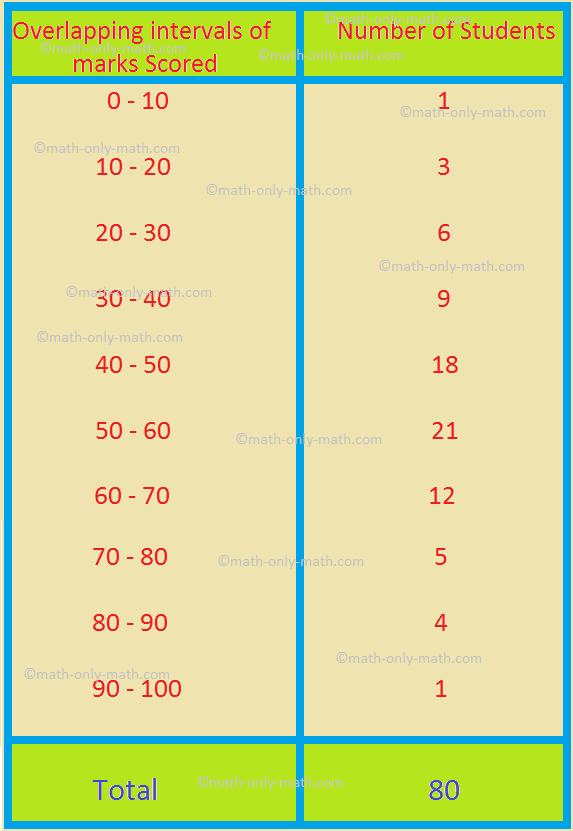Mathematics Grade 8 Probability Questions and Answers for Revision
Solution:
Total number of trials = 300 (Since there are 300 students all together).
Number of times a cricket player is chosen = 95 (Since 95 students play cricket).
Number of times a football player is chosen = 120.
Number of times a volleyball player is chosen = 80.
Number of times a student is chosen who plays no games = 5.
(i) Therefore, the probability of getting a player who plays volleyball
= Number of Times a Volleyball Player can be ChosenTotal Number of Trials
= 80300
= 415
(ii) The probability of getting a player who plays either cricket or volleyball
= Number of Times a Cricket or a Volleyball Player can be ChosenTotal Number of Trials
= 95+80300
= 175300
= 712
(iii) The probability of getting a player who plays neither football nor volleyball = Number of Times a Student can be Chosen who do not Play Football or VolleyballTotal Number of Trials
= 300–120−80300
= 100300
= 13
2. The blood group of 60 students of a class recorded as below.
| Blood Group | A | B | AB | O |
| Number of Students | 12 | 20 | 10 | 18 |
A student of the class is selected at random.
(i) What is the probability that the selected student has blood group O?
(ii) What is the probability that the selected student does not have blood group O?
Solution:
(i) Total number of trials = 60. [Since, there are 60 different students).
Number of students having blood group O = 18.
So, the probability of the student’s blood group being O
= Frequency of Favourable TrialsTotal Number of Trials
= Number of Students having Blood Group OTotal Number of Trials
= 1860
= 310
(ii) Total number of trials = 60. [Since, there are 60 different students).
Number of students not having blood group O = Total Number of Students – Number of Students having Blood Group O = 60 – 18 = 42.
So, the probability of the student’s blood group being different from O
= Number of Students not having Blood Group OTotal Number of Trials
= 4260
= 710
Note: Probability of the student’s blood group not being O = 310
+ 710
= 1.
3. In a test of 100 marks, the marks scored by the students of a class are given below.
A student of the class is selected at random. Find the probability that the student has scored
(i) less than 30
(ii) at least 60
(iii) not less than 80.
Solution:
(i) Total number of trials = 80 [Since there are 80 students all together].
Number of students scoring less than 30 = Cumulative frequency of the interval 20 – 30 = 1 + 3 + 6 = 10.
So, the probability of the student scoring less than 30
= Frequency of Favourable TrialsTotal Number of Trials
= Number of Students Scoring Less than 30Total Number of Students
= 1080
= 18
(ii) Total number of trials = 80.
Number of students scoring at least 60 = Number of students scoring more than or equal to 60
= 12 + 5 + 4 + 1 (= Sum of frequencies of the intervals 60 – 70, 70 – 80, 80 – 90, 90 – 100)
= 22.
So, the required probability = Frequency of Favourable TrialsTotal Number of Trials
= Number of Students Scoring at least 60Total Number of Students
= 2280
= 1140
(iii) Total number of trials = 80.
Number of students scoring at not less than 80 = Number of students scoring to least 80
= 4 + 1 (= Sum of frequencies of the intervals 80 – 90 and 90 – 100)
= 5.
Therefore, the required probability = Number of Students Scoring not less than 80Total Number of Students
= 580
= 116
4. A bag contains 8 red balls and some white balls. If the probability of drawing a white ball is half of the probability of drawing a red ball then find the number of white balls in the bag.
Solution:
Let the number of white balls be n.
The number of red balls = 8.
Therefore, the possible number of outcomes = n + 8.
Now, the probability of drawing a white ball = nn+8
The probability of drawing a red ball = 8n+8
Now, from question,
nn+8
= 12 ∙ nn+8
or, n = 4.
So, number of white balls in the bag is 4.
5. A box contains 90 discs numbered 1 to 90. One disc is drawn at random from the box. What is the probability that is bears
(i) a two-digit number
(ii) a perfect square
(iii) a multiply of 5
(iv) a number divisible by 3 and 5.
Solution:
(i) Total number of possible outcomes = 90 (Since the disks are numbered from 1 to 90).
Number of favourable outcomes of the event E
= Number of two-digit numbers from 1 to 90
= 90 – 9 = 81 (Since all are two-digit numbers except 1 to 9)
Therefore, P(E) = Number of Favourable Outcomes of the Event ETotal Number of Possible Outcomes
= 8190
= 910
(ii) Total number of possible outcomes = 90.
Number of favourable outcomes of the event F
= Number of perfect squares from 1 to 90
= 9 [Since 1, 4, 9, 16, 25, 36, 49, 64 and 81 are perfect squares).
Therefore, by definition, P(F) = 990
= 110
(iii) Total number of possible outcomes = 90.
Number of favourable outcomes of the event G
= Number of multiples of 5 among numbers from 1 to 90
= 18 [Since 5 × 1, 5 × 2, 5 × 3, …., 5 × 18 are multiple of 5).
Therefore, by definition, P(G) = 1890
= 15
(iv) Total number of possible outcomes = 90.
Number of favourable outcomes of the event H
= Number of numbers divisible by 3 and 5 from 1 to 90
= Number of numbers divisible by 15 from 1 to 90
= 6 [Since 15 × 1, 15 × 2, 15 × 3, …., 15 × 6 are divisible by 15).
Therefore, by definition, P(H) = 690
= 115



